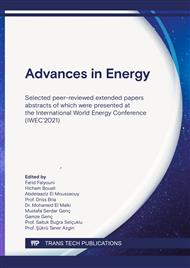[1]
N. Caselli, F. Intonti, F. La China, F. Biccari, F. Riboli, A. Gerardino, M. Gurioli, Generalized Fano lineshapes reveal exceptional points in photonic molecules, Nature Communications. 9 (2018) 1-8.
DOI: 10.1038/s41467-018-02855-3
Google Scholar
[2]
R. Ortuño, M. Cortijo, A. Martínez, Fano resonances and electromagnetically induced transparency in silicon waveguides loaded with plasmonic nanoresonators, Journal of Optics. 19 (2017) 025003-0250018.
DOI: 10.1088/2040-8986/aa51e0
Google Scholar
[3]
M.F. Limonov, M.V. Rybin, A.N. Poddubny, Y.S. Kivshar, Fano resonances in photonics, Nature Photonics. 11 (2017) 543-554.
DOI: 10.1038/nphoton.2017.142
Google Scholar
[4]
S. Paul, M. Ray, Simultaneous Switching at Multiple Wavelengths Using Plasmon Induced Transparency and Fano Resonance, IEEE Photonics Technology Letters. 29(2017) 739–742.
DOI: 10.1109/lpt.2017.2682919
Google Scholar
[5]
K. Ren, Y. Zhang, X. Ren, Y. He, Q. Han, Polarization-sensitive and active controllable electromagnetically induced transparency in U-shaped terahertz metamaterials, Frontiers of Optoelectronics. 14 (2021) 221-228.
DOI: 10.1007/s12200-019-0921-6
Google Scholar
[6]
M.F. Limonov, Fano resonance for applications, Advances in Optics and Photonics. 13 (2021) 703-771.
Google Scholar
[7]
Z. Wei, X. Li, N. Zhong, X. Tan, X. Zhang, H. Liu, R. Liang, Analogue Electromagnetically Induced Transparency Based on Low-loss Metamaterial and its Application in Nanosensor and Slow-light Device, Plasmonics. 12 (2016) 641–647.
DOI: 10.1007/s11468-016-0309-z
Google Scholar
[8]
Q. Wang, L. Yu, H. Gao, S. Chu, W. Peng, Electromagnetically induced transparency in an all-dielectric nano-metamaterial for slow light application, Optics express. 27 (2019) 35012-35026.
DOI: 10.1364/oe.27.035012
Google Scholar
[9]
U. Fano, Effects of configuration interaction on intensities and phase shifts, Physical Review. 124 (1961) 1866-1878.
DOI: 10.1103/physrev.124.1866
Google Scholar
[10]
A. Mouadili, E.H. El Boudouti, A. Soltani, A. Talbi, A. Akjouj, B.Djafari-Rouhani, Theoretical and experimental evidence of Fano-like resonances in simple monomode photonic circuits, Journal of Applied Physics. 113 (2013) 164101-11.
DOI: 10.1063/1.4802695
Google Scholar
[11]
X. Yang, M. Yu, D.L. Kwong, C.W. Wong, All-Optical Analog to Electromagnetically Induced Transparency in Multiple Coupled Photonic Crystal Cavities, Physical Review Letters. 102(2009) 173902-4.
DOI: 10.1103/physrevlett.102.173902
Google Scholar
[12]
F. Huibo, F.Hongwei, F. Huili, Multiple Fano resonances refractive index sensor based on plasmonic metal-insulator-metal based taiji resonator, sensors. 15 (2021) 22.
DOI: 10.1364/josab.441882
Google Scholar
[13]
M. Islam, K.M. Dhriti, R. Sarkar,G. Kumar, Tunable control of electromagnetically induced transparency effect in a double slot terahertz waveguide, Optics Communications. 483 (2021) 126632-126647.
DOI: 10.1016/j.optcom.2020.126632
Google Scholar
[14]
M. Heuck, T.K. Philip, Y. Elesin, M. Jesper, Improved switching using Fano resonances in photonic crystal structures, Optics letters. 38 (2013) 2466-2468.
DOI: 10.1364/ol.38.002466
Google Scholar
[15]
Y. Ben-Ali, Z. Tahri, A. Ouariach, D. Bria, Double frequency filtering by photonic comb-like, In:International Symposium on Advanced Electrical and Communication Technologies (ISAECT). IEEE, 2018. pp.1-6.
DOI: 10.1109/isaect.2018.8618798
Google Scholar
[16]
M.H. Cai Z.S. Xu, S.H. You, H.P. Liu, Sensitivity improvement of Rydberg atom-based microwave sensing via electromagnetically induced transparency, arXiv preprint arXiv. 2111 (2021) 06582.
Google Scholar
[17]
A. Muhammad, R. Ramzan, O. Siddiqui. Fano resonance based ultra high-contrast electromagnetic switch, Applied Physics Letters. 110 (2017) 181904.
DOI: 10.1063/1.4982725
Google Scholar
[18]
M. El-Aouni, Y. Ben-Ali, I. El Kadmiri, Z.Tahri, D. Bria, Electromagnetic Multi-Frequencies Filtering by a Defective Asymmetric Photonic Serial Loops Structure, In : International Conference on Electronic Engineering and Renewable Energy. Springer, Singapore, 2020. pp.195-202.
DOI: 10.1007/978-981-15-6259-4_19
Google Scholar
[19]
A. Mir, A. Akjouj, J.O. Vasseur, B. Djafari-Rouhani, N. Fettouhi, E.H. El Boudouti, J. Zemmouri, Observation of large photonic band gaps and defect modes in one-dimensional networked waveguides, Journal of Physics: Condensed Matter. 15 (2003) 1593.
DOI: 10.1088/0953-8984/15/10/308
Google Scholar
[20]
Y. Ben-Ali, Z. Tahri, D. Bria, Electromagnetic filters based on a single negative photonic comb-like structure, Progress In Electromagnetics Research C. 92 (2019) 41-56.
DOI: 10.2528/pierc18122001
Google Scholar



